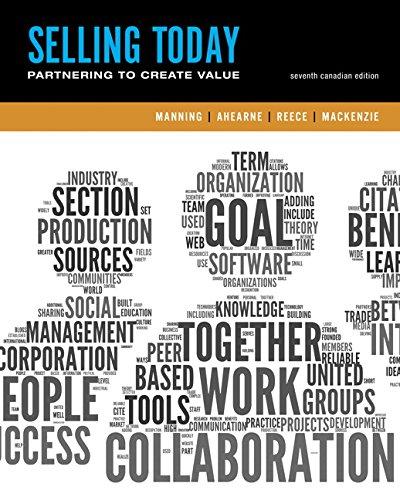Alex Homer, featured at the beginning of this chapter, works as a professional clothier for the Tom
Question:
Alex Homer, featured at the beginning of this chapter, works as a professional clothier for the Tom James Company ( www.tomjames.com ). Alex sells a comprehensive collection of high-quality attire: formal (black tie/tuxedo), business (suits), business casual (sport coats, slacks, etc.), and weekend (jeans, sport shirts, shorts, khakis, etc.). His clients are typically gentlemen and ladies who do not have time to go to the store, dislike the idea of store shopping, or have fit characteristics that present challenges for purchasing clothing “off-the-peg.”
For Alex, it is important to call on existing customers as well as prospects and to be aware of the different approaches used in each type of sales call. Typically, prior to visiting with an existing customer, he puts together clothing ideas for the season that make sense for the client based on how she/he dresses and how much her/
his closet is lacking in a particular area (such as shirts or slacks). For new prospects, Alex contacts them by telephone.
Realizing that cold-calling is an antiquated way of building a long-standing and fruitful sales career, the Tom James Company emphasizes the importance of referrals to build a business. Referrals tend to be easier to contact by phone and they typically purchase more in-person, due to the strength of the referrer’s name. All in all, referrals remove many obstacles to turning a person who is completely unaware of one’s business into a client.
According to Alex, the biggest challenge in his business is getting in front of people. This challenge stems from many possible sources: lack of time for the prospect, perceived price/value imbalance, lack of experience in in-office clothing shopping, and being perceived as a “suit”
company rather than an all-inclusive clothing provider.
Especially for repeat clients, who represent 80 percent of the company’s annual business, Alex Homer describes solid call preparation as key for successful selling. If the salesperson is unprepared and shows up in the client’s office with a bag in hand and a “what-are-you-buyingtoday?”
attitude, clients can sense this and become frustrated.
They understand that professional clothiers provide a service and expect them to be prepared as a partner/
problem solver regarding their wardrobes. As Alex puts it, “Stores provide clothing. Tom James provides a service.”
When it comes to understanding the needs of a prospect, Alex follows a certain sales process: He first asks his clients what is most important to them when they go clothing shopping. For most of his clients, it is one of four things: price, quality, fit, or trend-sensitivity. Based on that, he determines what clothing the client wears during the vital parts of their business (client meetings, board meetings, trials, close-the-sale presentations, speaking engagements, and so forth). Then he asks how they would evaluate their closet (excellent, good, fair, or poor).
Finally, if applicable, he finds out what it would take to make a slight improvement in their closet.
Questions
1. Does it appear that Tom James and Alex Homer have a personal selling philosophy like that described in this chapter? Provide examples that support each of the three prescriptions.
2. Put yourself in the position of Alex Homer. What might be the most rewarding and the most adverse aspects of his sales job?
3. Describe how Alex uses personal selling skills in utilizing existing knowledge and gathering new information from the customer in order to advance the sales process.
4. Discuss different ways in which Alex can actively generate good customer referrals.
5. What skills are particularly important for Alex’s sales job? Which of the four major sources of sales training outlined in this chapter would you recommend for acquiring those skills?
Step by Step Answer:

Selling Today Partnering To Create Value
ISBN: 9780133156850
7th Canadian Edition
Authors: Gerald L. Manning





